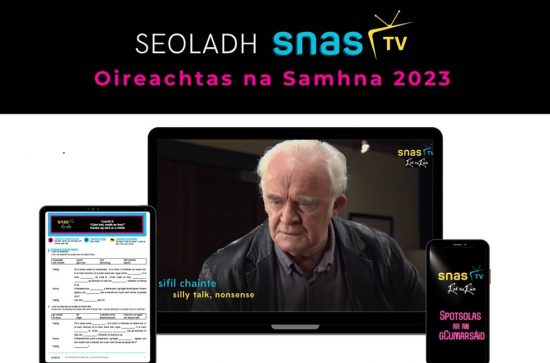
There was a large and lively gathering at the recent Oireachtas na Samhna Irish-language festival in Killarney for the launch of SnasTV, a collaborative project between the Centre for Irish Language at Maynooth University and TG4 Foghlaim. This new initiative will provide authentic resources based on TG4 programmes for teachers and learners of Irish.
SnasTV will develop and enhance Vifax, the pioneering teaching resource, which has been providing weekly Irish-language lessons based on Nuacht TG4 news bulletins for the past 25 years. Vifax was the brainchild of Anna Ní Ghallachair, former director of the Centre for Irish Language at Maynooth University, and was based on a model used for the teaching and learning of French at the University of Bordeaux. Anna, who was appointed Chair of the Board of TG4 last year, launched SnasTV on Saturday, together with well-known Ros na Rún actor, Niall Mac Eachmarcaigh.
Vifax was the first Irish-language resource to provide language learners with authentic video-based materials and was awarded the European Language Label for innovation at the time. As Ní Ghallachair explained at the launch, “The word Vifax is a combination of the words video and fax, an illustration of the technology on which the resource was based in its early years. Teachers and learners would video record TG4 news bulletins every Monday evening and the lessons would be sent to them by fax the next day! SnasTV reflects the technological advancements made since the creation of Vifax, by providing the same rich authentic teaching materials, adapted for a new generation of learners.
As well as the rebranding of Vifax as SnasTV Nuacht TG4, a companion series to the project, SnasTV Ros na Rún, has also been launched. This new series is based on the same approach as Vifax but with a focus on spoken informal Irish and on social interaction. Speaking at the launch about the rationale for this new series, Director of the Centre for the Irish Language, Aoife Ní Ghloinn, emphasised the significant difference, highlighted in recent years by applied and corpus linguistics, between the type of language used in writing or in formal speech and the type of discourse typical of social interaction. Informal conversations typically involve back-and-forth turn-taking and speakers collaborate to co-construct communication, using phrases or sounds known as backchannels, to respond appropriately to each other, to show that they are actively listening and to demonstrate understanding, agreement, disagreement, empathy and so on.
Experts in the field, said Ní Ghloinn, say that there is a gap in the provision of Irish-language learning resources that focus on the specific characteristics of spoken language and on spoken interaction. Learners of Irish often have great difficulty with these aspects of the language, which can make them reluctant to use Irish in social contexts outside the classroom.
Ambitious goals to increase the number of speakers who use Irish outside the education system have been set in the 20-year Strategy for Irish and in the Official Languages Act. If we want to achieve these aims, according to Ní Ghloinn, learners of Irish must be given the appropriate tools to help them bridge the gap between the Irish of schoolbooks and of classroom discourse, and the living language as it is used in everyday life. The Centre for Irish Language are hopeful that SnasTV Ros na Rún will provide the first step towards bridging that gap.
SnasTV Nuacht TG4 and SnasTV Ros na Rún will be available free of charge on the TG4 Foghlaim website and on the Centre’s brand new website, http://www.snas.ie. Professional development resources for teachers are also available on the new website, and a third section is being developed which will provide teaching and learning resources based on TEG syllabuses (Teastas Eorpach na Gaeilge / European Certificate in Irish language).
The staff of the Centre expressed their gratitude to the Department of Tourism, Culture, Arts, Gaeltacht, Sports & Media and to COGG who provide financial support for this project. They also thanked TG4, TG4 Foghlaim and Ros na Rún for their collaboration in making these resources available.
